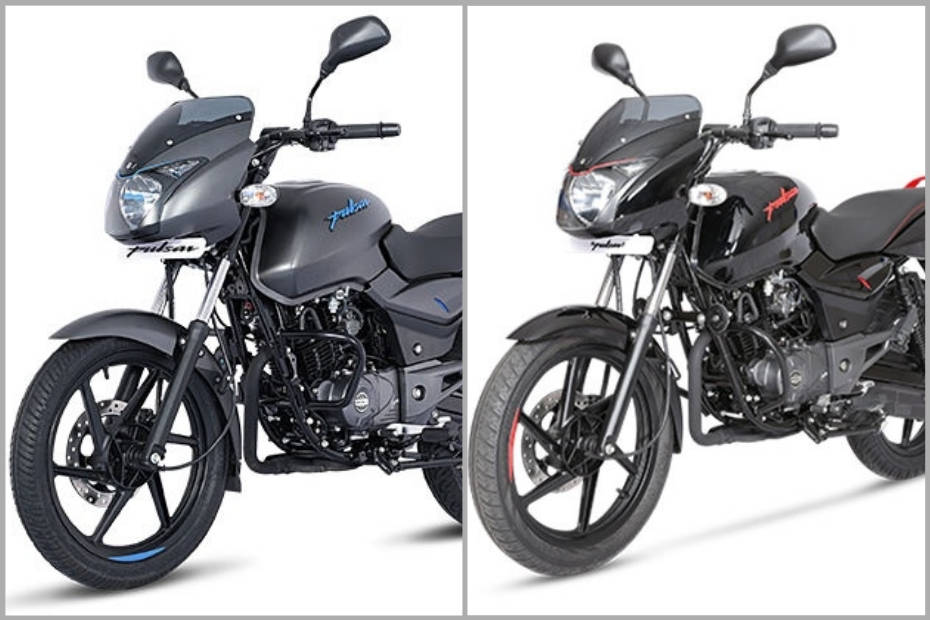Bajaj Pulsar 125 Neon vs Pulsar 150 Neon: Spec Comparison
Published On Aug 15, 2019 11:06 AM By Praveen M.for Bajaj Pulsar 125
- 419597 Views
While both bikes look similar, things are different when it comes to specs!

Bajaj recently launched the Pulsar 125 Neon starting at Rs 64,000 (ex-showroom Delhi). This makes the motorcycle the most affordable one under the Pulsar lineup. While it is based heavily on the existing Pulsar 150 Neon, there are quite some differences in terms of mechanicals and here’s what they’re all about:
Pricing:

The Pulsar 125 Neon costs Rs 64,000 for the front drum brake-equipped variant whereas the disc brake model costs Rs 66,618. On the other hand, the Pulsar 150 Neon costs Rs 71,200, which is around Rs 4500 more expensive than the top-end variant of the Pulsar 125 Neon. The Pulsar 150 offers great value considering it gets more power and the safety of ABS. All prices are ex-showroom Delhi.
Powertrain:

|
Specifications |
Bajaj Pulsar 125 Neon |
Bajaj Pulsar 150 Neon |
|
Engine |
124.4cc single-cylinder air-cooled |
149.5cc single-cylinder, air-cooled |
|
Peak power |
12PS at 8500rpm |
14PS at 8000rpm |
|
Maximum torque |
11Nm at 6500rpm |
13.4Nm at 6000rpm |
|
Transmission |
5-speed |
5-speed |
Though the Pulsar 125 comes with a smaller engine, it falls behind the Pulsar 150 Neon only by 2PS and 2.4Nm. Compared to its 150cc counterpart, the output figure arrives in 500rpm later, so in theory, you might have to push the engine a little harder. However, revving hard shouldn’t be bothersome as the bike gets a counterbalancer, which should make the overall engine refinement even better. That being said, we’ll reserve our comments on the performance front until we get to test the motorcycle.
Underpinnings:

|
Specifications |
Bajaj Pulsar 125 Neon |
Bajaj Pulsar 150 Neon |
|
Front suspension |
Telescopic fork |
Telescopic fork |
|
Rear suspension |
Twin Nitrox shock absorbers |
Twin Nitrox shock absorbers |
|
Front brake |
240mm disc / 170mm drum with CBS |
240mm disc with single-channel ABS |
|
Rear brake |
130mm drum with CBS |
130mm drum |
|
Front tyre |
80/100 x 17 Tubeless |
80/100 17 Tubeless |
|
Rear tyre |
100/90 x 17 Tubeless |
100 / 90 - 17 Tubeless |
Since both the bikes use the same chassis, it isn’t surprising that the underpinnings are all the same. The only difference is that the smaller Pulsar gets the option of a front drum brake. While both the disc and drum brake variants feature CBS, the Pulsar 150 Neon gets a single-channel ABS which should offer much better safety when it comes to braking hard.
Dimensions:

|
Specifications |
Bajaj Pulsar 125 Neon |
Bajaj Pulsar 150 Neon |
|
Length x Width x Height |
2055mm x 755mm x 1060mm |
2055mm x 755mm x 1060mm |
|
Ground Clearance |
165mm |
165mm |
|
Wheelbase |
1320mm |
1320mm |
|
Kerb weight |
140kg |
144kg |
|
Fuel tank capacity |
11.5 litres |
15 litres |
Despite the fact that the Pulsar 125 gets a smaller fuel tank, it is too early to say which motorcycle would offer more range as the baby Pulsar’s inherently smaller engine might just be more frugal to offset the difference in fuel tank capacity. We’ll get a clearer picture once we get our hands on both the bikes for a detailed test.
Verdict:

The Pulsar 125 Neon gets a lot of things in common with its bigger 150cc counterpart. That’s a good thing as Bajaj hasn’t cut corners on crucial aspects, especially when it comes to underpinnings. Overall, you get a 125cc motorcycle that’s almost as good as the Pulsar 150 Neon (at least on paper) at a pocket-friendly price point. And that’s a great way to attract buyers who want a good balance of style, and fuel efficiency. However, for those who want a more well-rounded motorcycle with performance genes and ABS, the Rs 4500 premium over the Pulsar 125 Neon looks like a pretty solid deal.
